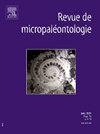日本西南京都北部Kanbayashi地区Ultra-Tamba地体Kozuki组晚古生代放射虫
IF 1
Q4 PALEONTOLOGY
引用次数: 0
摘要
日本西南部内带的超坦巴地体被解释为一个与俯冲有关的瓜达鲁普系(中二叠世)至洛平系(晚二叠世)的吸积杂岩。小月组是大地构造的UT3单元,主要分布在冈山县东部和兵库县西部。近年来,根据其岩性特征和构造位置的相似性,认为在京都北部的Kanbayashi地区也存在Kozuki组。直到现在,人们才知道这个地层的确切年龄。本研究在两个剖面中发现了放射虫化石,从而确定了Kozuki组燧石和碎屑的年龄。燧石岩产放射虫,如Curvalbailella u-forma (Holdsworth和Jones)和Curvalbailella chilensis (Ling和Forsythe),它们表明石炭世晚期或早早早早,早二叠世;泥岩产放射虫,如latentifbanchengensis Wang, Pseudotormentus cfh . kamigoriensis De Wever和Caridroit, Quadriremis gracilis (De Wever和Caridroit),它们表明瓜达卢普期到洛平期,但最有可能是瓜达卢普期。本研究将研究区Kozuki组确定为Ultra-Tamba Terrane UT3单元的一部分,确认了其与其他区域的年龄相关性,并强调了该单元的最东北延伸。本文章由计算机程序翻译,如有差异,请以英文原文为准。
Late Paleozoic radiolarians from the Kozuki Formation of the Ultra-Tamba Terrane in the Kanbayashi area, northern Kyoto Prefecture, Southwest Japan
The Ultra-Tamba Terrane within the Inner Zone of Southwest Japan is interpreted as a Guadalupian (Middle Permian) to Lopingian (Late Permian) subduction-related accretionary complex. The Kozuki Formation is the UT3 unit of the terrane and is mainly present in eastern Okayama and western Hyogo prefectures. Recently, it was shown that the Kozuki Formation is also distributed in the Kanbayashi area of northern Kyoto Prefecture based on the similarity of its lithological features and tectonic position. The exact age of the formation was unknown until now. In this study, radiolarian fossils are discovered in two sections, allowing for the determination of the ages of cherts and clastics within the Kozuki Formation. The cherts yielded radiolarians such as Curvalbailella u-forma (Holdsworth and Jones) and Curvalbailella chilensis (Ling and Forsythe), which indicate a latest Carboniferous or early Cisuralian, Early Permian age, and the mudstones yielded radiolarians such as Latentifistula banchengensis Wang, Pseudotormentus cf. kamigoriensis De Wever and Caridroit, Quadriremis gracilis (De Wever and Caridroit), which indicate Guadalupian to Lopingian, but most likely Guadalupian, age. This study establishes the Kozuki Formation in the studied area as a part of the UT3 unit of the Ultra-Tamba Terrane, confirms its age correlation with other regions, and emphasizes the northeasternmost extension of the unit.
求助全文
通过发布文献求助,成功后即可免费获取论文全文。
去求助
来源期刊

REVUE DE MICROPALEONTOLOGIE
PALEONTOLOGY-
CiteScore
2.50
自引率
0.00%
发文量
17
期刊介绍:
La Revue de micropaléontologie publie 4 fois par an des articles de intérêt international, consacrés à tous les aspects de la micropaléontologie. Les textes, en anglais ou en français, sont des articles originaux, des résultats de recherche, des synthèses et mises au point, des comptes rendus de réunions scientifiques et des analyses de ouvrages. La revue se veut résolument ouverte à tous les aspects de la micropaléontologie en accueillant des travaux traitant de la systématique des microfossiles (et de leurs équivalents actuels), des bactéries aux microrestes de vertébrés, et de toutes leurs applications en sciences biologiques et géologiques.
 求助内容:
求助内容: 应助结果提醒方式:
应助结果提醒方式:


